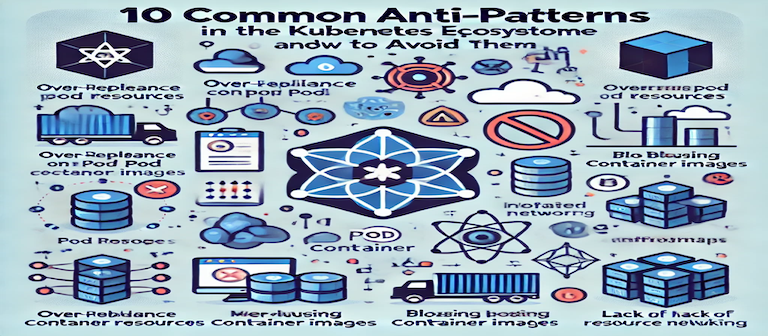10 Common Anti-Patterns in the Kubernetes Ecosystem and How to Avoid Them
 Nan Song
Nan Song
Kubernetes has become the go-to platform for container orchestration, allowing organizations to scale applications efficiently. However, while it offers immense flexibility, it also presents opportunities for inefficient practices, often referred to as anti-patterns. These are common missteps that can affect the scalability, performance, and maintainability of Kubernetes environments. In this blog, we’ll explore 10 such anti-patterns and offer guidance on how to avoid them.
1. Over-Reliance on Pod-Level Resources
The Problem: Relying too heavily on pod-level resources (e.g., local storage, memory, CPU) can create issues with resource utilization and portability. Pods are designed to be ephemeral, so over-dependence on their resources can cause problems when they are rescheduled or fail.
The Solution: Instead of using pod-local resources, leverage Kubernetes Persistent Volumes (PV) for storage and ConfigMaps/Secrets for configuration. This way, your application remains stateless, and any pod termination or movement won’t affect its functionality.
2. Misusing or Overusing ConfigMaps and Secrets
The Problem: Some users store large amounts of data, or even sensitive information like API keys, in ConfigMaps and Secrets, which can lead to inefficiency and security risks.
The Solution: Use ConfigMaps and Secrets strictly for lightweight configurations or sensitive data that must remain encrypted. For larger datasets, use a proper data storage mechanism such as a database or a Persistent Volume (PV). Always encrypt sensitive data and avoid storing large payloads in ConfigMaps.
3. Monolithic Containerization
The Problem: Some teams package entire monolithic applications into a single container. This approach negates the core benefits of microservices, making deployments less scalable and harder to maintain.
The Solution: Split monolithic applications into smaller, loosely-coupled microservices that each run in their own container. This not only improves scalability but also simplifies updates, as individual services can be modified and deployed independently.
4. Lack of Resource Limits and Quotas
The Problem: Failing to set resource limits for CPU and memory on pods can lead to resource contention, where certain applications consume too many resources, negatively affecting others.
The Solution: Define resource requests and limits for each pod to ensure balanced resource allocation. Additionally, use ResourceQuotas in your namespaces to prevent teams from overusing resources.
resources:
requests:
memory: "256Mi"
cpu: "250m"
limits:
memory: "512Mi"
cpu: "500m"
5. Ignoring Pod Health Probes
The Problem: Not configuring liveness and readiness probes for your pods can lead to undetected failures and degraded performance, as unhealthy pods continue to serve traffic.
The Solution: Implement liveness probes to automatically restart failing containers and readiness probes to ensure that a pod only starts receiving traffic when it’s fully initialized and ready to serve.
livenessProbe:
httpGet:
path: /healthz
port: 8080
initialDelaySeconds: 5
periodSeconds: 5
6. Bloated Container Images
The Problem: Large container images can slow down deployments and increase storage costs. Bloated images often contain unnecessary files, dependencies, and tools, making them harder to maintain.
The Solution: Optimize your container images by using multi-stage builds and only including necessary dependencies. For example, use smaller base images like alpine and avoid including build tools or development libraries in production images.
7. Overutilization of Persistent Volumes
The Problem: Some workloads overuse Persistent Volumes (PVs), which may not be necessary for all types of applications. Relying too heavily on PVs can result in unnecessary complexity and storage costs.
The Solution: Use stateful storage only for workloads that require persistence, such as databases. For stateless applications, rely on ephemeral storage provided by pods or external storage mechanisms, like object storage (e.g., AWS S3).
8. Unnecessary Resource Sharing Among Microservices
The Problem: Allowing multiple microservices to share resources, such as databases or storage volumes, can create tight coupling between services. This reduces scalability and makes the architecture more fragile.
The Solution: Follow the microservices principle of isolation by ensuring each service manages its own resources independently. Use persistent volumes or databases with appropriate access controls, preventing unintended interactions between services.
9. Inefficient or Over-Complicated Networking Configurations
The Problem: Over-complicating Kubernetes networking by adding unnecessary networking layers, custom routing, or not leveraging native networking solutions can lead to performance bottlenecks and increased management overhead.
The Solution: Keep your networking configuration simple. Utilize Kubernetes Services for service discovery and Network Policies for security. Use native tools like CNI plugins (e.g., Calico, Flannel) to manage networking efficiently, instead of building overly custom network setups.
10. Overlooking Horizontal Pod Autoscaling (HPA) Opportunities
The Problem: Not using Horizontal Pod Autoscaling (HPA) can result in over-provisioned resources, where applications are assigned fixed resources regardless of workload fluctuations, leading to inefficiencies and higher costs.
The Solution: Implement Horizontal Pod Autoscaling to automatically scale your pods based on CPU, memory, or custom metrics, allowing your application to handle variable traffic without over-provisioning.
apiVersion: autoscaling/v2beta2
kind: HorizontalPodAutoscaler
metadata:
name: my-app-hpa
spec:
scaleTargetRef:
apiVersion: apps/v1
kind: Deployment
name: my-app
minReplicas: 2
maxReplicas: 10
metrics:
- type: Resource
resource:
name: cpu
target:
type: Utilization
averageUtilization: 75
Conclusion
Kubernetes is a powerful platform, but like any tool, it must be used correctly to avoid pitfalls. By recognizing these common anti-patterns and adopting best practices, you can ensure your Kubernetes deployments are efficient, secure, and scalable. Whether it’s optimizing container images, leveraging Horizontal Pod Autoscaling, or configuring proper health probes, small changes can lead to big improvements in performance and reliability.
Subscribe to my newsletter
Read articles from Nan Song directly inside your inbox. Subscribe to the newsletter, and don't miss out.
Written by
